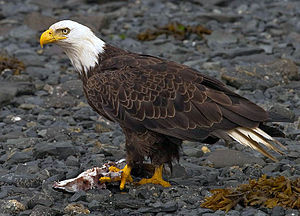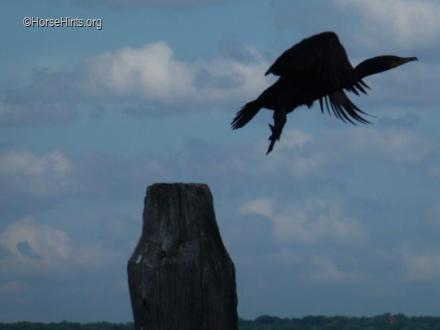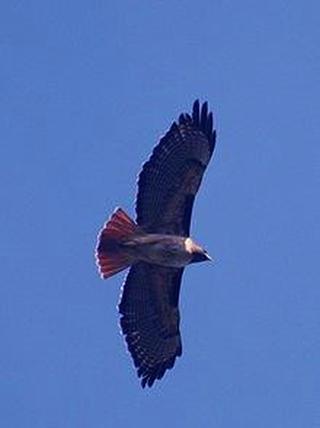Bill and I have been enjoying learning all about the birds that we see while on our kayaking adventures. Below is an index of the birds that we have been able to identify as well as a link for reach bird that will tell you all about each type of bird:
American Coot
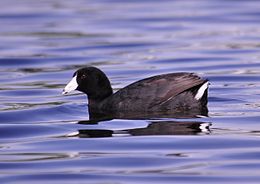
"The American coot (Fulica americana), also known as a mud hen, is a bird of the family Rallidae. Though commonly mistaken to be ducks, American coots belong to a distinct order. Unlike the webbed feet of ducks, coots have broad, lobed scales on their lower legs and toes that fold back with each step in order to facilitate walking on dry land. Coots live near water, typically inhabiting wetlands and open water bodies in North America. Groups of coots are called covers or rafts. The oldest known coot lived to be 22 years old.
The American coot is a migratory bird that occupies most of North America. It lives in the Pacific and southwestern United States and Mexico year-round and occupies more northeastern regions during the summer breeding season. In the winter they can be found as far south as Panama. Coots generally build floating nests and lay 8-12 eggs per clutch. Females and males have similar appearances, but they can be distinguished during aggressive displays by the larger ruff (head plumage) on the male. American coots eat primarily algae and other aquatic plants but also animals (both vertebrates and invertebrates) when available.
The American coot is listed as 'Least Concern' under the IUCN conservation ratings. Hunters generally avoid killing American coots because their meat is not as sought after as that of ducks.
Much research has been done on the breeding habits of American coots. Studies have found that mothers will preferentially feed offspring with the brightest plume feathers, a characteristic known as chick ornaments. American coots are also susceptible to conspecific brood parasitism and have evolved mechanisms to identify which offspring are theirs and which are from parasitic females...."
Top HomeBald Eagle
"The bald eagle (Haliaeetus leucocephalus, from Greek hali- = sea, aietos = eagle, leuco- = white, cephalos = head) is a bird of prey found in North America. A sea eagle, it has two known sub-species and forms a species pair with the white-tailed eagle (Haliaeetus albicilla). Its range includes most of Canada and Alaska, all of the contiguous United States, and northern Mexico. It is found near large bodies of open water with an abundant food supply and old-growth trees for nesting.
The bald eagle is an opportunistic feeder which subsists mainly on fish, which it swoops down and snatches from the water with its talons. It builds the largest nest of any North American bird and the largest tree nests ever recorded for any animal species, up to 4 m (13 ft) deep, 2.5 m (8.2 ft) wide, and 1 metric ton (1.1 short tons) in weight. Sexual maturity is attained at the age of four to five years. Bald eagles are not actually bald; the name derives from an older meaning of 'white headed'. The adult is mainly brown with a white head and tail. The sexes are identical in plumage, but females are about 25 percent larger than males. The beak is large and hooked. The plumage of the immature is brown.
The bald eagle is both the national bird and national animal of the United States of America. The bald eagle appears on its Seal. In the late 20th century it was on the brink of extirpation in the continental United States. Populations recovered and the species was removed from the U.S. federal government's list of endangered species on July 12, 1995 and transferred to the list of threatened species. It was removed from the List of Endangered and Threatened Wildlife in the Lower 48 States on June 28, 2007. ..."
Top HomeCardinal
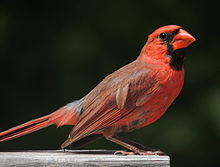
Male Cardinal
"...The male Northern Cardinal is perhaps responsible for getting more people to open up a field guide than any other bird. They're a perfect combination of familiarity, conspicuousness, and style: a shade of red you can't take your eyes off. Even the brown females sport a sharp crest and warm red accents. Cardinals don't migrate and they don't molt into a dull plumage, so they're still breathtaking in winter's snowy backyards. In summer, their sweet whistles are one of the first sounds of the morning...." Cardinal/Cornell Lab of Ornithology ![]()
Cormorant
"The bird family Phalacrocoracidae or the cormorants is represented by some 40 species of cormorants and shags. Several different classifications of the family have been proposed recently, and the number of genera is disputed.
There is no consistent distinction between cormorants and shags. The names cormorant and shag were originally the common names of the two species of the family found in Great Britain, Phalacrocorax carbo (now referred to by ornithologists as the great cormorant) and P. aristotelis (the European shag). 'Shag' refers to the bird's crest, which the British forms of the great cormorant lack. As other species were discovered by English-speaking sailors and explorers elsewhere in the world, some were called cormorants and some shags, depending on whether they had crests or not. Sometimes the same species is called a cormorant in one part of the world and a shag in another, e.g., the great cormorant is called the black shag in New Zealand (the birds found in Australasia have a crest that is absent in European members of the species). Van Tets (1976) proposed to divide the family into two genera and attach the name 'cormorant' to one and 'shag' to the other, but this flies in the face of common usage and has not been widely adopted.
The scientific genus name is Latinised Ancient Greek, (phalakros, 'bald') and (korax, 'raven'). This is often thought to refer to the creamy white patch on the cheeks of adult great cormorants, or the ornamental white head plumes prominent in Mediterranean birds of this species, but is certainly not a unifying characteristic of cormorants. 'Cormorant' is a contraction derived either directly from Latin corvus marinus, 'sea raven' or through Brythonic Celtic. Cormoran is the Cornish name of the sea giant in the tale of Jack the Giant Killer. Indeed, 'sea raven' or analogous terms were the usual terms for cormorants in Germanic languages until after the Middle Ages. The French explorer André Thévet commented in 1558 that "...the beak [is] similar to that of a cormorant or other corvid," which demonstrates that the erroneous belief that the birds were related to ravens lasted at least to the 16th century.
Cormorants and shags are medium-to-large seabirds. They range in size from the pygmy cormorant (Phalacrocorax pygmaeus), at as little as 45 cm (18 in) and 340 g (12 oz), to the flightless cormorant (Phalacrocorax harrisi), at a maximum size 100 cm (40 in) and 5 kg (11 lb). The recently extinct spectacled cormorant (Phalacrocorax perspicillatus) was rather larger, at an average size of 6.3 kg (14 lb). The majority, including nearly all Northern Hemisphere species, have mainly dark plumage, but some Southern Hemisphere species are black and white, and a few (e.g. the spotted shag of New Zealand) are quite colourful. Many species have areas of coloured skin on the face (the lores and the gular skin) which can be bright blue, orange, red or yellow, typically becoming more brightly coloured in the breeding season. The bill is long, thin, and sharply hooked. Their feet have webbing between all four toes, as in their relatives.
They are coastal rather than oceanic birds, and some have colonised inland waters - indeed, the original ancestor of cormorants seems to have been a fresh-water bird, judging from the habitat of the most ancient lineage. They range around the world, except for the central Pacific islands. All are fish-eaters, dining on small eels, fish, and even water snakes. They dive from the surface, though many species make a characteristic half-jump as they dive, presumably to give themselves a more streamlined entry into the water. Under water they propel themselves with their feet, though some also propel themselves with their wings. Some cormorant species have been found, using depth gauges, to dive to depths of as much as 45 metres.
After fishing, cormorants go ashore, and are frequently seen holding their wings out in the sun. All cormorants have preen gland secretions that are used ostensibly to keep the feathers waterproof. Some sources state that cormorants have waterproof feathers while others say that they have water permeable feathers. Still others suggests that the outer plumage absorbs water but does not permit it to penetrate the layer of air next to the skin. The wing drying action is seen even in the flightless cormorant but commonly in the Antarctic shags and red-legged cormorants. Alternate functions suggested for the spread-wing posture include that it aids thermoregulation, digestion, balances the bird or indicates presence of fish. A detailed study of the great cormorant concludes that it is without doubt to dry the plumage.
Cormorants are colonial nesters, using trees, rocky islets, or cliffs. The eggs are a chalky-blue colour. There is usually one brood a year. The young are fed through regurgitation. They typically have deep, ungainly bills, showing a greater resemblance to those of the pelicans', to which they are related, than is obvious in the adults...."
Top HomeBufflehead Duck
![]() Bufflehead Duck AKA Spirit Duck
Bufflehead Duck AKA Spirit Duck ![]()
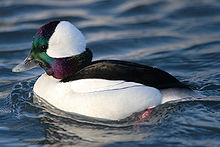
Male Duck Bufflehead Duck
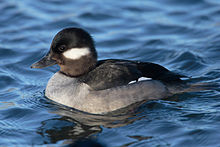
Female Bufflehead Duck
The bufflehead (Bucephala albeola) is a small American sea duck of the genus Bucephala, the goldeneyes. This species was first described by Linnaeus in his Systema naturae in 1758 as Anas albeola.
Description: The Bufflehead ranges from 32-40 cm (13-16 in) long and 270-550 g (9.5-19.4 oz), with the drakes larger than the females. Averaging 35.5 cm (14.0 in) and 370 g (13 oz), it rivals the green-winged teal as the smallest American duck. Adult males are striking black and white, with iridescent green and purple heads with a large white patch behind the eye. Females are grey-toned with a smaller white patch behind the eye and a light underside. The name bufflehead is a combination of buffalo and head, referring to the oddly bulbous head shape of the species. This is most noticeable when the male puffs out the feathers on the head, thus greatly increasing the apparent size of the head.
Distribution and Habitat: They are migratory and most of them winter in protected coastal waters, or open inland waters, on the east and west coasts of North America and the southern United States. The Bufflehead is an extremely rare vagrant to western Europe. Their breeding habitat is wooded lakes and ponds in Alaska and Canada, almost entirely included in the boreal forest or taiga habitat.
Behavior: Buffleheads have evolved their small size in order to fit the nesting cavity of their 'etabiotic' host, a woodpecker, the northern flicker. Due to their small size, they are highly active, undertaking dives almost continuously while sustained by their high metabolism. They do not tend to collect in large flocks; groups are usually limited to small numbers. One duck will serve as a sentry, watching for predators as the others in the group dive in search of food. Buffleheads are amongst the last waterfowl to leave their breeding grounds and one of the world's most punctual migrants, arriving on their wintering grounds within a narrow margin of time. ..."
Top HomeEgret
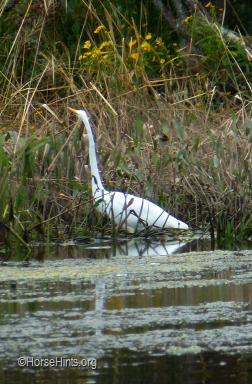
"An egret is a bird that is any of several herons, most of which are white or buff, and several of which develop fine plumes (usually milky white) during the breeding season.
Biology: Many egrets are members of the genera Egretta or Ardea which also contain other species named as herons rather than egrets. The distinction between a heron and an egret is rather vague, and depends more on appearance than biology. The word 'egret' comes from the French word 'aigrette' that means both 'silver heron' and 'brush', referring to the long filamentous feathers that seem to cascade down an egret's back during the breeding season.
Several of the egrets have been reclassified from one genus to another in recent years: the great egret, for example, has been classified as a member of either Casmerodius, Egretta or Ardea. In the 19th and early part of the 20th century, some of the world's egret species were endangered by relentless plume hunting, since hat makers in Europe and the United States demanded large numbers of egret plumes, leading to breeding birds being killed in many places around the world. Several Egretta species, including the eastern reef egret, the reddish egret and the western reef egret have two distinct colours, one of which is entirely white. The little blue heron has all-white juvenile plumage...." ![]() Egret
Egret ![]()
Golden Eye Duck
Shortcuts to Duck ID![]() Goldeneye Duck aka The Whistler
Goldeneye Duck aka The Whistler ![]()
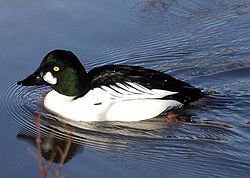
"Goldeneye or whistler (Bucephala clangula) is a species of small tree-hole nesting northern hemisphere seaducks belonging to the genus Bucephala. The plumage is black and white. Goldeneyes eat fish, crustaceans and other marine life. The 'whistler' name comes from the noise their beating wings make in flight. The bufflehead was formerly separated in its own genus Charitonetta, while the goldeneyes proper were mistakenly placed in Clangula (as Clangula americana), the genus of the long-tailed duck which at that time was placed in Harelda.
The three living species are:
- Common goldeneye Bucephala clangula: they have black bills. Males have a dark green head with a white spot near the bill, under their eye. Females have brown heads.
- Barrow's goldeneye Bucephala islandica
- Bufflehead Bucephala albeola (See article above)
Known fossil taxa are:
- Bucephala cereti (Sajóvölgyi Middle Miocene of Mátraszõlõs, Hungary - Late Pliocene of Chilhac, France)
- Bucephala ossivalis (Late Miocene/Early Pliocene of Bone Valley, USA), which was very similar to the Common Goldeneye and may even have been a paleosubspecies or direct ancestor Bucephala fossilis (Late Pliocene of California, USA)
- Bucephala angustipes (Early Pleistocene of central Europe)
- Bucephala sp. (Early Pleistocene of Dursunlu, Turkey: Louchart et al. 1998) "
Grebe

"A grebe is a member of the order Podicipediformes and the only type of bird associated with this order. It is a widely distributed order of freshwater diving birds, some of which visit the sea when migrating and in winter. This order contains only a single family, the Podicipedidae, containing 22 species in 6 extant genera. Grebes are small to medium-large in size, have lobed toes, and are excellent swimmers and divers. However, although they can run for a short distance, they are prone to falling over, since they have their feet placed far back on the body.
Grebes have narrow wings, and some species are reluctant to fly; indeed, two South American species are completely flightless. They respond to danger by diving rather than flying, and are in any case much less wary than ducks. Extant species range in size from the least grebe, at 120 grams (4.3 oz) and 23.5 cm (9.3 inches), to the great grebe, at 1.7 kg (3.8 lbs) and 71 cm (28 inches).
However, the North American and Eurasian species are all, of necessity, migratory over much or all of their ranges, and those species that winter at sea are also seen regularly in flight. Even the small freshwater pied-billed grebe of North America has occurred as a transatlantic vagrant to Europe on more than 30 occasions.
Bills vary from short and thick to long and pointed, depending on the diet, which ranges from fish to freshwater insects and crustaceans. The feet are always large, with broad lobes on the toes and small webs connecting the front three toes. The hind toe also has a small lobe. Recent experimental work has shown that these lobes work like the hydrofoil blades of a propeller. Curiously, the same mechanism apparently evolved independently in the extinct Cretaceous-age Hesperornithiformes, which are totally unrelated birds.
Grebes have unusual plumage. It is dense and waterproof, and on the underside the feathers are at right-angles to the skin, sticking straight out to begin with and curling at the tip. By pressing their feathers against the body, grebes can adjust their buoyancy. Often, they swim low in the water with just the head and neck exposed. In the non-breeding season, grebes are plain-coloured in dark browns and whites. However, most have ornate and distinctive breeding plumages, often developing chestnut markings on the head area, and perform elaborate display rituals. The young, particularly those of the Podiceps genus, are often striped and retain some of their juvenile plumage even after reaching full size. In the breeding season, they mate at freshwater lakes and ponds, but some species spend their non-breeding season along seacoasts.
When preening, grebes eat their own feathers, and feed them to their young. The function of this behaviour is uncertain but it is believed to assist with pellet formation,[4] and to reduce their vulnerability to gastric parasites. Grebes make floating nests of plant material concealed among reeds on the surface of the water. The young are precocial, and able to swim from birth...."
Top HomeHeron
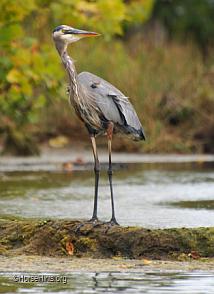

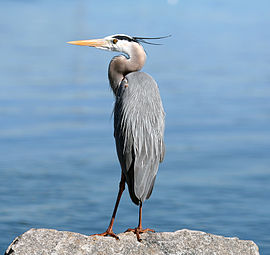
"The herons are long-legged freshwater and coastal birds in the family Ardeidae, with 64 recognised species (some are called 'egrets' or 'bitterns' instead of 'heron'). Within Ardeidae, all members of the genera Botaurus and Ixobrychus are referred to as 'bitterns', and - including the zigzag heron or zigzag bittern - are a monophyletic group within the Ardeidae. However, egrets are not a biologically distinct group from the herons, and tend to be named differently because they are mainly white or have decorative plumes. Although egrets have the same build as herons, they tend to be smaller.
The classification of the individual heron/egret species is fraught with difficulty, and there is still no clear consensus about the correct placement of many species into either of the two major genera, Ardea and Egretta. Similarly, the relationship of the genera in the family is not completely resolved. However, one species formerly considered to constitute a separate monotypic family Cochlearidae, the boat-billed heron, is now regarded as a member of the Ardeidae.
Although herons resemble birds in some other families, such as the storks, ibises, spoonbills and cranes, they differ from these in flying with their necks retracted, not outstretched. They are also one of the bird groups that have powder down. Some members of this group nest colonially in trees, while others, notably the bitterns, use reed beds. ..." ![]() Herons
Herons ![]()
Belted Kingfisher
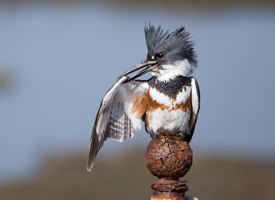 "With its top-heavy physique, energetic flight, and piercing rattle, the Belted Kingfisher seems to have an air of self-importance as it patrols up and down rivers and shorelines. It nests in burrows along earthen banks and feeds almost entirely on aquatic prey, diving to catch fish and crayfish with its heavy, straight bill. These ragged-crested birds are a powdery blue-gray; males have one blue band across the white breast, while females have a blue and a chestnut band. ..." Kingfisher
"With its top-heavy physique, energetic flight, and piercing rattle, the Belted Kingfisher seems to have an air of self-importance as it patrols up and down rivers and shorelines. It nests in burrows along earthen banks and feeds almost entirely on aquatic prey, diving to catch fish and crayfish with its heavy, straight bill. These ragged-crested birds are a powdery blue-gray; males have one blue band across the white breast, while females have a blue and a chestnut band. ..." Kingfisher
Osprey
"Osprey, (Pandion haliaetus), sometimes known as the sea hawk, fish eagle, river hawk or fish hawk, is a diurnal, fish-eating bird of prey. It is a large raptor, reaching more than 60 cm (24 in) in length and 180 cm (71 in) across the wings. It is brown on the upperparts and predominantly greyish on the head and underparts. The osprey tolerates a wide variety of habitats, nesting in any location near a body of water providing an adequate food supply. It is found on all continents except Antarctica, although in South America it occurs only as a non-breeding migrant.
As its other common name suggests, the osprey's diet consists almost exclusively of fish. It possesses specialised physical characteristics and exhibits unique behaviour to assist in hunting and catching prey. As a result of these unique characteristics, it has been given its own taxonomic genus, Pandion and family, Pandionidae. Four subspecies are usually recognized, one of which has recently been given full species status. Despite its propensity to nest near water, the osprey is not classed as a sea-eagle. ..."
Top HomeRed Tailed Hawk
"The red-tailed hawk (Buteo jamaicensis) is a bird of prey, one of three species colloquially known in the United States as the 'chickenhawk,' though it rarely preys on standard sized chickens. It breeds throughout most of North America, from western Alaska and northern Canada to as far south as Panama and the West Indies, and is one of the most common buteos in North America. Red-tailed hawks can acclimate to all the biomes within their range. There are fourteen recognized subspecies, which vary in appearance and range. It is one of the largest members of the genus Buteo in North America, typically weighing from 690 to 1,600 g (1.52 to 3.53 lb) and measuring 45-65 cm (18-26 in) in length, with a wingspan from 110-145 cm (43-57 in). The red-tailed hawk displays sexual dimorphism in size, with females averaging about 25% heavier than males. The bird is sometimes referred to as the red-tail for short, when the meaning is clear in context. ...
The red-tailed hawk occupies a wide range of habitats and altitudes, including deserts, grasslands, coniferous and deciduous forests, tropical rainforests, agricultural fields and urban areas. It lives throughout the North American continent, except in areas of unbroken forest or the high arctic. It is legally protected in Canada, Mexico and the United States by the Migratory Bird Treaty Act.
Because they are so common and easily trained as capable hunters, the majority of hawks captured for falconry in the United States are red-tails. Falconers are permitted to take only passage hawks (which have left the nest, are on their own, but are less than a year old) so as to not affect the breeding population. Adults, which may be breeding or rearing chicks, may not be taken for falconry purposes and it is illegal to do so. Passage red-tailed hawks are also preferred by falconers because these younger birds have not yet developed adult behaviors, which will make training substantially more challenging...."
Top HomeSharp-shinned Hawk (Smaller lookalike is the Sharp-shinned Hawk) or Cooper's Hawk
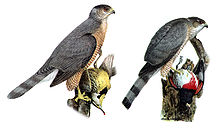
Comparison of Cooper's Hawk (left), Sharp-shinned Hawk (right)
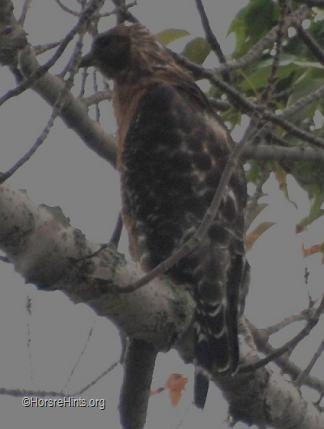 The picture of the left was taken while we were visiting Mason Neck State Park in Virginia. This is a lovely kayaking destination. It was difficult to try to identify this hawk; however, with careful consideration and comparison Bill and I decided that it looked more like a Sharp-shinned Hawk than a Cooper's Hawk. The tail was straight across and not curved at the end, the body was more curved or hunched than the Cooper's Hawk, the head looked smaller and the beak was more hooked.
The picture of the left was taken while we were visiting Mason Neck State Park in Virginia. This is a lovely kayaking destination. It was difficult to try to identify this hawk; however, with careful consideration and comparison Bill and I decided that it looked more like a Sharp-shinned Hawk than a Cooper's Hawk. The tail was straight across and not curved at the end, the body was more curved or hunched than the Cooper's Hawk, the head looked smaller and the beak was more hooked.
"...The northern group is easily mistaken for the slightly larger and lankier Cooper's hawk, which match the sharp-shinned in plumage. In flight, the Cooper's, with its longer wings and larger head, is sometimes compared to a 'flying cross'; whereas the broader-winged and smaller-headed sharp-shinned is described as a 'flying mallet'...." ![]() Sharp-shinned Hawk
Sharp-shinned Hawk ![]()
"...Among the bird world's most skillful fliers, Cooper's Hawks are common woodland hawks that tear through cluttered tree canopies in high speed pursuit of other birds. You're most likely to see one prowling above a forest edge or field using just a few stiff wingbeats followed by a glide. With their smaller lookalike, the Sharp-shinned Hawk, Cooper's Hawks make for famously tricky identifications. Both species are sometimes unwanted guests at bird feeders, looking for an easy meal (but not one of sunflower seeds)...." Cooper's Hawk ![]()
Turkey Vulture, Turkey Buzzard or Buzzard
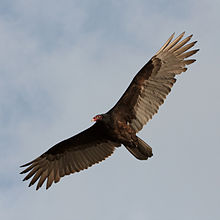
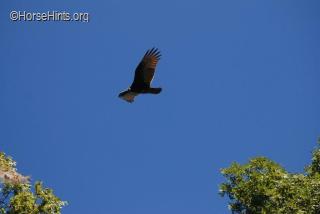
"The turkey vulture (Cathartes aura), also known in some North American regions as the turkey buzzard (or just buzzard), and in some areas of the Caribbean as the John crow or carrion crow, is the most widespread of the New World vultures. One of three species in the genus Cathartes, in the family Cathartidae, the turkey vulture ranges from southern Canada to the southernmost tip of South America. It inhabits a variety of open and semi-open areas, including subtropical forests, shrublands, pastures, and deserts.
It, like all New World vultures, is not related to the Old World vultures of Europe, Africa, and Asia. It looks nearly identical because of convergent evolution, where natural selection similarly shapes unrelated animals adapting to the same conditions.
The turkey vulture is a scavenger and feeds almost exclusively on carrion. It finds its food using its keen eyes and sense of smell, flying low enough to detect the gases produced by the beginnings of the process of decay in dead animals. In flight, it uses thermals to move through the air, flapping its wings infrequently. It roosts in large community groups. Lacking a syrinx-the vocal organ of birds-its only vocalizations are grunts or low hisses. It nests in caves, hollow trees, or thickets. Each year it generally raises two chicks, which it feeds by regurgitation. It has very few natural predators. In the United States, the vulture receives legal protection under the Migratory Bird Treaty Act of 1918.]..." ![]() Turkey Vulture
Turkey Vulture


